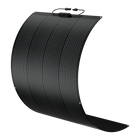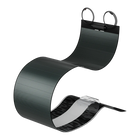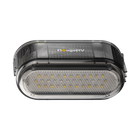A detail Introduction of CIGS Solar Panel System

For many years, the only way to generate solar energy was with the use of conventional solar panels. These panels were typically bulky and heavy, which means that they can only be used in a limited number of places. Thin film solar panels, on the other hand, are lighter and unbreakable. They’re also more flexible, which means that they can be used in places that a traditional solar panel can’t—such as on the window panes of buildings, rooftops, and outdoors.
The most famous and highly flexible type of thin-film solar panel uses Cadmium Selenide (CdSe) as the active material and generates free energy for all your electronic devices by capturing sunlight. In this post, we’ll cover what is CIGS solar panel system, how it works, and why it’s a good investment for your home.
- What is the CIGS type of thin film solar panels?
- The function of a CIGS solar system
- Do CIGS panels really worth it?
- Summary
- Why BougeRV panels are worthwhile?
- FAQ

What is the CIGS type of thin film solar panels?
These PV panels are actually copper indium gallium selenide solar cells sometimes referred to as CIGS solar panels which are the best types of thin-film solar panels that are widely used in portable, domestic and commercial applications. They are used to generate electricity from sunlight and produce direct (DC) currents with considerable efficiency. This means that they convert sunlight into power just like the traditional crystalline panels do. CIGS panels use Cadmium sulfide (CdS) as the active absorber layer that captures maximum sunlight.
The function of a CIGS solar system
The CIGS solar cell has a series of semiconductor layers of different properties stacked in order. These thin films are deposited onto a substrate which is then used to create solar panels. This panel is sandwiched between multiple transparent conducting layers and protective cover glass to perform the generation process of DC from photons or sunlight.
When sunlight hits the CIGS solar panel, the photons hit the top layer of the device. Then pass through the Cadmium sulfide (CdS) layer, which makes the photons move from the n-side to the p-type of photovoltaic material resulting in energy generation. In it, the Cadmium sulfide (CdS) layer is used as an absorbing layer which plays a vital role in the whole electricity generation process.
Do CIGS panels really worth it?
CIGS solar panels have become a popular choice for residential and large-scale solar panel systems, and they enhance the building's aesthetics too when used as building integrated (BIPV) modules. The technology allows the use of lower-cost solar panels to produce electricity, and it is especially useful in locations with low sunlight. The cost-effectiveness, portability, and other user-friendly features enable us to say that they are really worth it.
A 100w flexible solar panel by BougeRV delivers unbelievable performance and value for money no matter if you are at the home, in your boat, or RV for a joyful trip or a healthy outdoor activity. You can use them, fold them and they're ready to be a companion for all your electricity needs.
High absorption of sun rays and higher efficiency
The Cadmium sulfide layer (CdS) absorbs the incoming light energy (sun rays) more effectively and transfers it to the photovoltaic materials (PV cells). When more sunlight is absorbed, more sunlight is converted into electricity and efficiency becomes maximum.
Fewer power losses because of more sensitivity to light
The CIGS solar system provides a great solution to the world's energy crisis. CIGS solar panels are more efficient and less power is lost because they are much more sensitive to light than conventional crystalline panels.
Multi-purpose use due to flexibility and portable design
CIGS can be used as your primary source of electricity or bring them to your RV for a camping trip, you can use them as your emergency backup power or your main power source. The portable design makes it easy to use and transport. You can take it with you wherever you go. You can fold it and use it whenever you need to generate electricity.
Durability and free from vulnerability to micro-cracks
The crystalline modules are made up of silicon wafers which makes them vulnerable to cracking and severe damage during transportation while CIGS solar panels don't have hence being best for both residential and industrial applications.
Summary
Solar panels are the best backup source for all your electrical and electronic equipment whether you're at a home, outdoors, or anywhere. Small to large-scale businesses can equally reap the long-lasting benefits of solar power and cut down their energy costs by a handsome percentage.
As CIGS solar cells have excellent electrical characteristics and mechanical properties, they are widely used worldwide to power up electronics and home appliances. CIGS solar panels are efficient, more sensitive to light, and produce energy with full potential.
Why BougeRV panels are worthwhile?
BougeRV is highly professional in delivering customer-tailored solar solutions for a clean green environment. We have a huge range of solar kits, flexible CIGS panels, and PV modules in different ratings that are sufficient to provide a handsome power backup whenever you need it.
Why choose us…?
- High-Quality PV panels at an affordable cost
- Wide range of solar panel kits best for home, camping, outdoor
- Every product proves its power and performance
- Great customer feedback
FAQ
What makes CIGS panels a great choice?
The CIGS panels are flexible and are amazingly portable as compared to other solar panels on the market, this feature is sufficient to make them a great choice for many of us.
Are CIGS panels safe to transport?
CIGS panels are not manufactured with delicate silicon wafers hence safe to transport. When you send your CIGS panels to a different location or country, you don't have to worry about them.
Do CIGS panels affect by shade?
These panels reduce energy production by around 10-20 percent which is far less than 60-80 percent of crystalline panels.
What is the temperature effect on CIGS panels?
Power production of CIGS modules declines approx. 0.3% per degree Celsius temperature raises which is considered best than the crystalline panel’s 0.6% per degree Celsius temperature raises.




































